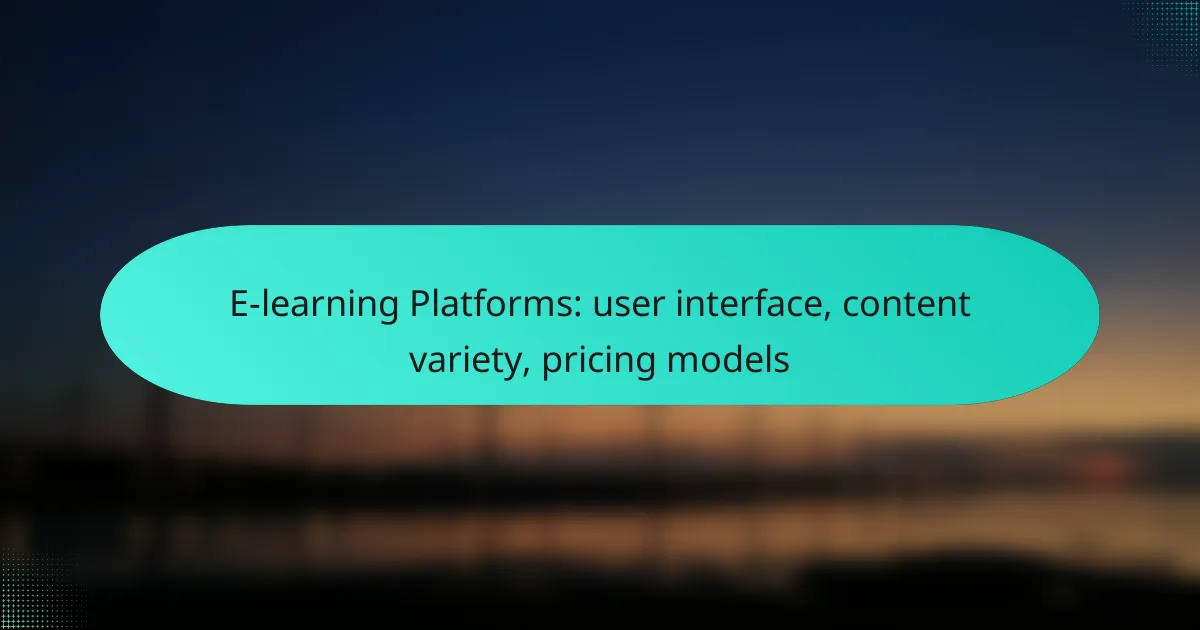E-learning platforms have transformed education by offering a diverse array of courses, user-friendly interfaces, and flexible pricing models tailored to various learning preferences. With options like Coursera, Udemy, and LinkedIn Learning, users can access engaging content that includes video lectures, interactive quizzes, and discussion forums, all designed to enhance the learning experience. A well-crafted user interface plays a crucial role in facilitating navigation and engagement, ultimately improving educational outcomes.

What are the best e-learning platforms in Canada?
The best e-learning platforms in Canada offer a range of courses, user-friendly interfaces, and various pricing models to suit different learning needs. Popular options include Coursera, Udemy, LinkedIn Learning, Skillshare, and edX, each providing unique features and content variety.
Coursera
Coursera partners with top universities and organizations to offer courses, specializations, and degrees. Users can access a wide array of subjects, from computer science to humanities, often with the option to earn accredited certificates.
Pricing typically includes free courses, with paid options ranging from CAD 50 to CAD 300 for certificates. Consider the value of certification versus free content based on your career goals.
Udemy
Udemy is known for its extensive library of courses created by individual instructors. This platform covers diverse topics, making it suitable for learners of all interests and skill levels.
Courses on Udemy are usually priced between CAD 20 and CAD 200, with frequent discounts. Look for user reviews and ratings to ensure course quality before purchasing.
LinkedIn Learning
LinkedIn Learning offers a professional focus, providing courses that enhance workplace skills and career development. Users can access thousands of video tutorials on topics like software development, marketing, and project management.
A subscription model costs around CAD 30 per month, granting unlimited access to all courses. This is ideal for those seeking continuous learning and skill enhancement in their careers.
Skillshare
Skillshare emphasizes creative skills, offering courses in areas such as design, photography, and writing. The platform encourages project-based learning, allowing users to apply skills immediately.
Membership costs about CAD 20 per month, with a free trial available. This is a good option for learners who prefer hands-on projects and community interaction.
edX
edX provides high-quality courses from universities and institutions worldwide, focusing on academic subjects and professional development. Many courses are available for free, with the option to pay for verified certificates.
Pricing for verified certificates ranges from CAD 50 to CAD 300. Consider edX if you’re looking for rigorous academic content and the possibility of earning university credit.

How do user interfaces impact e-learning experiences?
User interfaces significantly affect e-learning experiences by influencing user engagement and learning efficiency. A well-designed interface can enhance navigation, accessibility, and overall satisfaction, making it easier for learners to access and absorb content.
Intuitive navigation
Intuitive navigation is crucial for a positive e-learning experience, as it allows users to find content quickly and easily. Clear menus, logical content organization, and recognizable icons can help learners focus on studying rather than struggling with the interface.
For example, a platform that uses a breadcrumb trail allows users to see their current location within the course structure, making it easier to backtrack or explore related topics. Avoid complex layouts that may confuse users, and ensure that essential features are easily accessible.
Responsive design
Responsive design ensures that e-learning platforms function well across various devices, such as desktops, tablets, and smartphones. This adaptability is essential, as learners may access content from different devices depending on their preferences and situations.
To achieve responsive design, use flexible layouts that adjust to screen sizes and orientations. Test your platform on multiple devices to ensure that all features are usable and visually appealing, regardless of the device. Prioritize mobile-friendly interfaces, as many users prefer learning on the go.
Accessibility features
Accessibility features are vital for ensuring that all learners, including those with disabilities, can effectively engage with e-learning content. Implementing features like screen reader compatibility, keyboard navigation, and adjustable text sizes can significantly enhance the learning experience for users with diverse needs.
Adhering to established guidelines, such as the Web Content Accessibility Guidelines (WCAG), can help you create a more inclusive platform. Regularly seek feedback from users with disabilities to identify areas for improvement and ensure that your platform meets their needs effectively.

What types of content do e-learning platforms offer?
E-learning platforms provide a diverse range of content types designed to enhance the learning experience. Key offerings typically include video lectures, interactive quizzes, discussion forums, and downloadable resources, each serving a unique purpose in the educational process.
Video lectures
Video lectures are a primary content type on e-learning platforms, allowing learners to engage with material presented by instructors. These lectures can vary in length, typically ranging from a few minutes to over an hour, and often include visual aids like slides or animations to enhance understanding.
When selecting courses, consider the quality of video production and the instructor’s delivery style, as these factors significantly impact engagement and retention. Look for platforms that offer high-definition video and clear audio to ensure a better learning experience.
Interactive quizzes
Interactive quizzes are designed to reinforce learning and assess understanding in real-time. These quizzes can range from multiple-choice questions to more complex problem-solving tasks, providing immediate feedback to learners.
Utilizing quizzes effectively can help identify knowledge gaps and areas needing improvement. Choose platforms that offer a variety of quiz formats and allow for retakes, as this encourages mastery of the material.
Discussion forums
Discussion forums facilitate interaction among learners and instructors, promoting collaborative learning. These forums allow users to ask questions, share insights, and engage in debates, creating a community around the course content.
Active participation in forums can enhance understanding and retention of material. Look for platforms that have well-moderated forums with clear guidelines to foster constructive discussions and prevent misinformation.
Downloadable resources
Downloadable resources, such as PDFs, slides, and supplementary materials, provide learners with additional tools to support their studies. These resources can be used for offline review and often include study guides, reference materials, or practice exercises.
When choosing a platform, check the availability and quality of downloadable resources, as they can significantly enhance the learning experience. Ensure that these materials are regularly updated to reflect the latest information and best practices in the field.

What are common pricing models for e-learning platforms?
Common pricing models for e-learning platforms include subscription-based pricing, pay-per-course pricing, and freemium models. Each model offers distinct advantages and considerations, impacting how users access and pay for educational content.
Subscription-based pricing
Subscription-based pricing allows users to pay a recurring fee, typically monthly or annually, to access a wide range of courses and materials. This model often provides unlimited access to content, making it appealing for learners who want to explore various subjects.
When considering subscription plans, users should evaluate the total cost over time and the variety of content offered. Platforms like Coursera and LinkedIn Learning often use this model, with prices ranging from around $20 to $50 per month.
Pay-per-course pricing
Pay-per-course pricing requires users to pay a one-time fee for each course they wish to take. This model is suitable for learners who prefer to focus on specific topics without committing to a subscription. Prices can vary widely, often ranging from $10 to several hundred dollars depending on the course’s depth and provider.
When choosing this model, it’s essential to consider the value of the course content and any additional resources provided. Platforms like Udemy and Skillshare commonly utilize this pricing structure.
Freemium models
Freemium models offer basic access to courses for free, with the option to purchase premium features or advanced courses. This approach allows users to try out the platform without any financial commitment, which can be beneficial for those uncertain about investing in e-learning.
However, users should be aware that while free content can be valuable, it may be limited in scope. Platforms like Duolingo and Khan Academy exemplify this model, providing a range of free resources while offering paid options for enhanced learning experiences.

How to choose the right e-learning platform?
Choosing the right e-learning platform involves evaluating user interface, content variety, and pricing models. Prioritize platforms that align with your learning style, budget, and specific educational needs.
User Interface
The user interface (UI) of an e-learning platform significantly impacts the learning experience. A clean, intuitive design allows users to navigate easily, find resources quickly, and engage with content without frustration. Look for platforms that offer customizable dashboards and mobile-friendly layouts.
Consider testing the platform’s UI through free trials or demos. A good UI should facilitate seamless interaction with features like quizzes, forums, and multimedia content. Avoid platforms with cluttered designs or complicated navigation, as these can hinder learning.
Content Variety
Content variety is crucial when selecting an e-learning platform. A diverse range of courses, including video lectures, interactive exercises, and reading materials, caters to different learning preferences. Ensure the platform covers the subjects you are interested in and offers content from reputable sources.
Check if the platform provides access to user-generated content or community-driven resources, which can enhance learning opportunities. Platforms that regularly update their course offerings and include various formats, such as podcasts or webinars, are often more engaging.
Pricing Models
Understanding the pricing models of e-learning platforms is essential for making an informed choice. Common models include subscription-based access, one-time payments for individual courses, or pay-per-use options. Evaluate which model fits your budget and learning goals.
Some platforms offer tiered pricing, where higher tiers provide additional features like personalized coaching or exclusive content. Be cautious of hidden fees or automatic renewals that can increase costs unexpectedly. Always read the terms and conditions before committing to a subscription.
